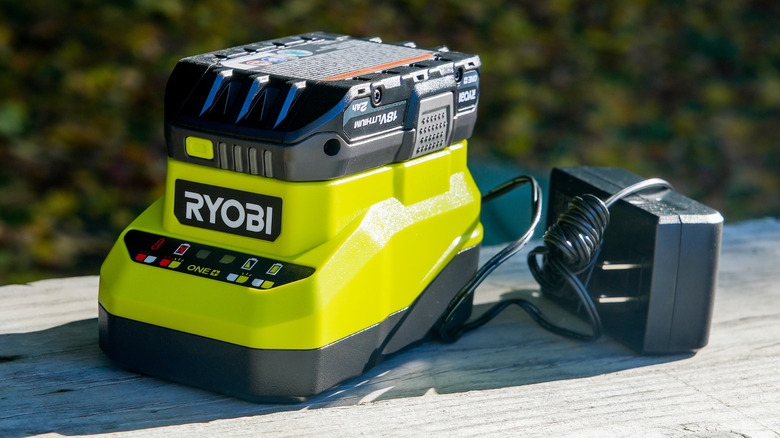The Warning Sign Your Ryobi Battery Is Overheating (And How Long It Takes To Cool Down)
As one of the many power tool lines that has made battery power its top priority, Ryobi has developed a strong line of batteries. They come in different sizes and voltages to help you get whatever job you're tackling done right. Not to mention, if you're unsure, it's easy to find which Ryobi battery system goes with your tool. At the same time, they have their limits. Fortunately, they can let you know when they're approaching them so you can act accordingly. For instance, Ryobi batteries will alert you when they're beginning to overheat.
There are a few ways to tell if a Ryobi battery is starting to overheat or is already dangerously overheated. First and foremost is the most obvious sign, that the battery is unusually hot to the touch. The other major sign comes from the LED lights on the battery, which are typically used to let you know how battery charging is going. If all of the LEDs are flashing, or the first and last are flashing, the battery is overheating, and you should stop using it. If it's the two middle LEDs flashing, this is a sign of overcurrent protection kicking in, meaning the battery is being pushed beyond its limits.
Overheating is no joke when it comes to power tools, as an overheating battery presents some serious danger. That's why it's important to not only know when a Ryobi unit is overheating, but also how to prevent it and safely respond.
Giving your Ryobi battery enough time to cool down is crucial
There are a few common issues with Ryobi tool batteries, with overheating being one of the most prominent. This phenomenon happens so often that it's an established issue for Ryobi and other tool brands. There are several potential causes for overheating, including prolonged exposure to high temperatures, pushing the battery and the tool it's attached to so hard that heat accumulates, and internal battery damage that negatively impacts temperature regulation. Thankfully, avoiding and reversing overheating is indeed possible so long as you're vigilant.
In most cases, it's as simple as letting your Ryobi battery cool down. You should stop using it, remove the battery from the tool, and let it cool off on a stable surface in a room-temperature, well-ventilated area. It should only take approximately 15 to 20 minutes for the battery to cool down. Once it's at a regulated, room-temperature level, it's safe to put it back on the charger or in the tool you were using.
Still, you should keep a close eye on it once it's reattached to one of these items, just in case it quickly heats up again. If it does, there is likely more cause for concern, like a battery malfunction that means it shouldn't be used further. Ryobi's batteries are strong, but even they can struggle. That's why being mindful of their condition and temperature is crucial to getting the most out of them and keeping yourself safe.

